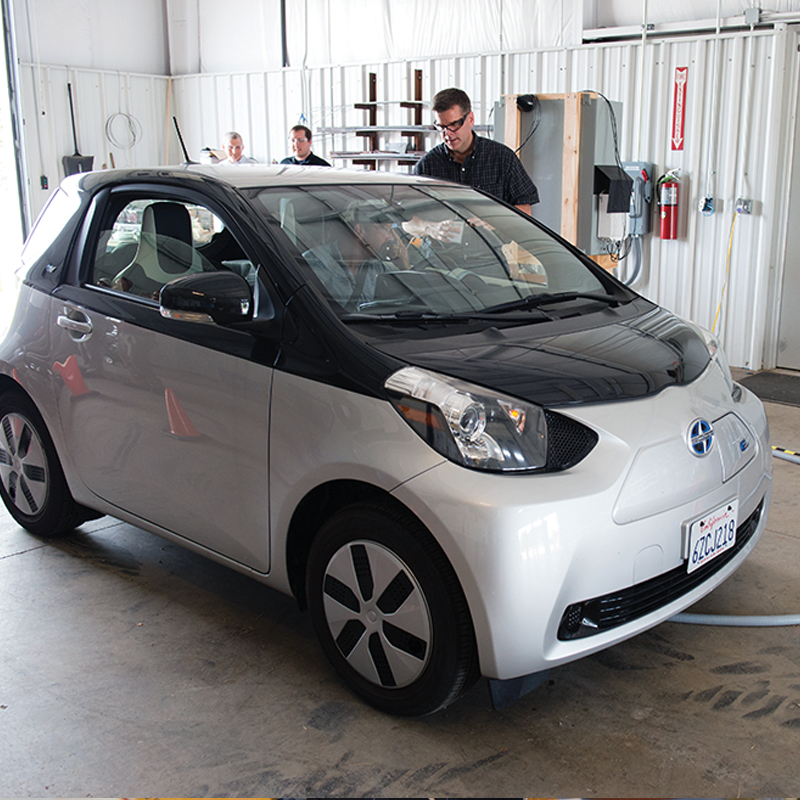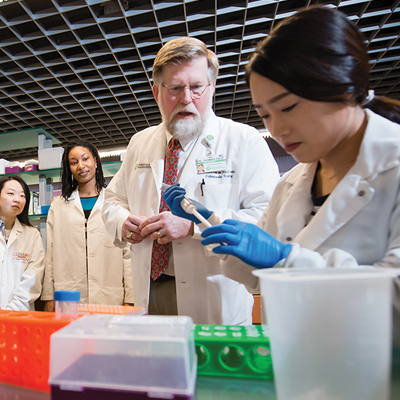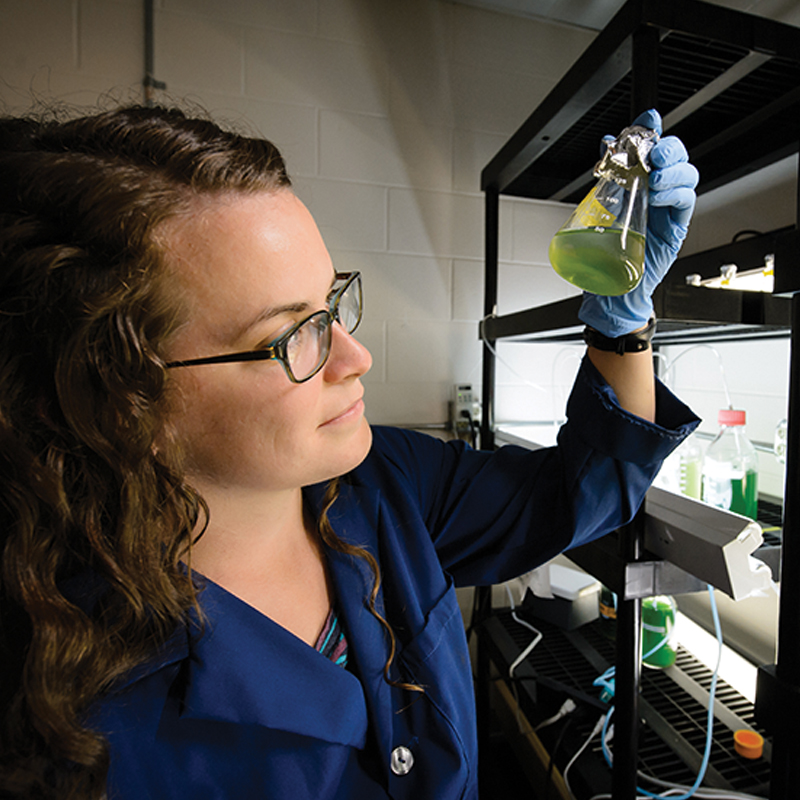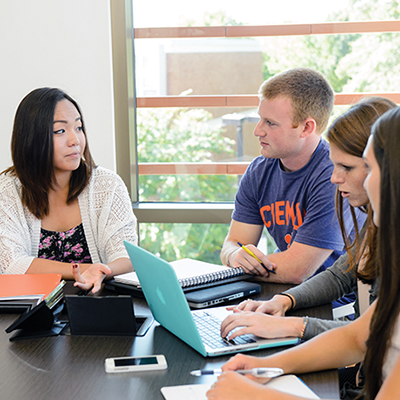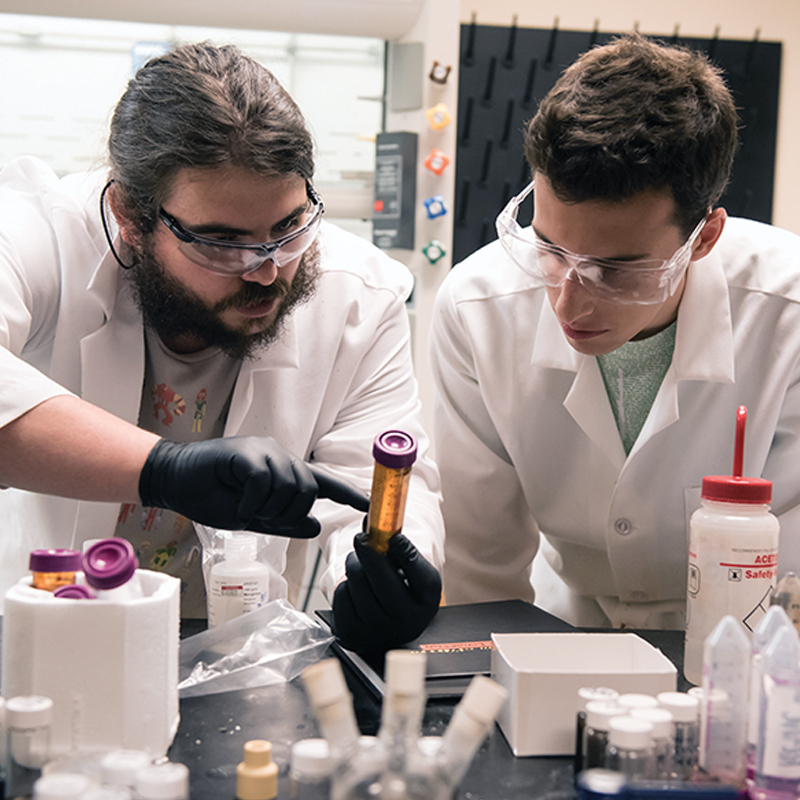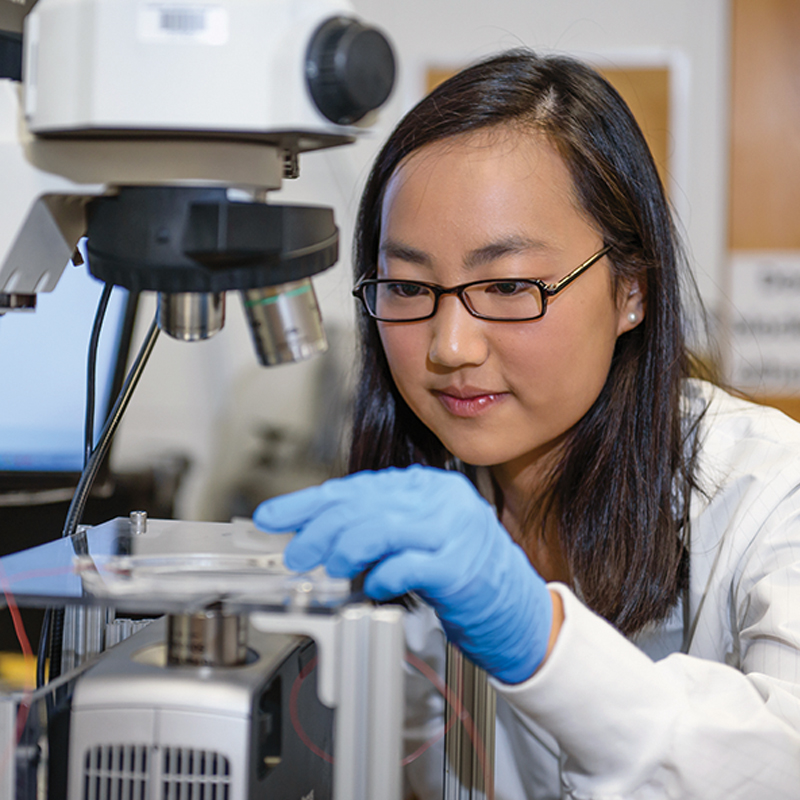Shaping Our Future
Meet Clemson faculty members tackling real-world problems and a philanthropist who helps make it possible.
Student Spotlight
An undergraduate student and two Ph.D. candidates discuss using their education in the service of others.
Alumni Spotlight
Bob and Dan Stanzione reflect on the values that led to their success.
Facility Spotlight
Learn how services at Fluor Study Hall connect math, engineering and science students with trained tutors.
FROM THE DEAN
The faculty is the beating heart of the College of Engineering, Computing and Applied Sciences. From them flows the research that creates jobs and the students who become the leaders of tomorrow. Those same leaders will be the alumni who generously give their time and money to help improve the Clemson experience for generations yet to come. It is imperative that we continually work to strengthen our faculty, just as runners condition their hearts to go faster and longer for the next race.
We recently announced the appointment of five new endowed chairs. These are among the most distinguished positions within the University’s faculty and are central to enhancing South Carolina’s knowledge-based economy in strategically important areas. Funding for these positions comes from private or nonprofit contributors with matching dollars provided by the SmartState program. Some of the most recent appointees to these endowed chairs are featured in the following pages and include:
■ Johan Enslin, the Duke Energy Endowed Chair in Smart Grid Technology and executive director of the energy systems program at the Clemson University Restoration Institute
■ Jeremy Gilbert, the Hansjörg Wyss Endowed Chair for Regenerative Medicine
■ Venkat Krovi, the Michelin Endowed Chair in Vehicle Automation
■ Laine Mears, the BMW SmartState Chair in Automotive Manufacturing
■ Hai Yao, the Ernest R. Norville Endowed Chair in Biomedical Engineering and associate chair for the Clemson-MUSC Bioengineering Program
This issue focuses on faculty, students and alumni who are doing great things in areas of significance to the state, nation and world.
Stephen Foulger, the Gregg-Graniteville Endowed Professor, is leading a nationwide team that has received $6 million to search for new ways of stimulating specific parts of the brain.
Sez Atamturktur, the Distinguished Professor of Intelligent Infrastructure, played leadership roles in two grants from the National Science Foundation totaling $6.4 million. She is the principal investigator on a $3 million grant through the NSF’s Research Traineeship Program and spearheaded the grant application process on a successful $3.4 million ADVANCE grant.
Amod Ogale and Srikanth Pilla are both faculty members who are doing cutting edge research in composite materials, a booming business in South Carolina. Companies in the composites and advanced materials sector announced $1.5 billion in capital investment from 2006-13, creating more than 2,700 jobs, according to the state Department of Commerce.
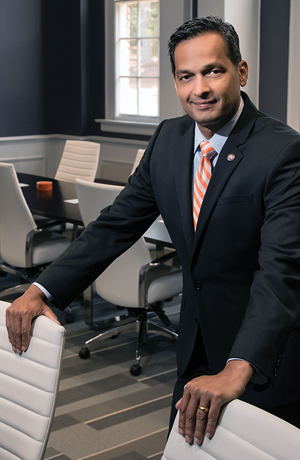
Companies in the composites and advanced materials sector announced $1.5 billion in capital investment from 2006-13, creating more than 2,700 jobs, according to the state Department of Commerce.
Our faculty are also excelling in the classroom. One example is Brian Dean, an associate professor in the School of Computing. His high ratings from students helped him win the Philip Prince Award for Innovation in Teaching. Dean volunteers a tremendous amount of time doing educational outreach, especially for the USA Computing Olympiad. Thousands of high school students have used the program to improve their computational problem-solving skills.
This issue also features some highly accomplished students who are already having an impact. Shakira Hobbs and Myrtede Alfred, both Ph.D. candidates, braved a hurricane in Belize to help a village convert waste to methane as an energy source. Undergraduate student body president Joey Wilson has conducted honors research and traveled the world while earning a degree in bioengineering.
Finally, we feature three alumni who have achieved great success in their careers and gone above and beyond in supporting the college and Clemson as a whole. Bob and Dan Stanzione are the only set of brothers to be inducted into the Thomas Green Clemson Academy of Engineers and Scientists, the college’s highest honor. Thomas Hash, also an academy member, has established an endowed chair in sustainable development with a generous gift.
Our legacy will depend in large measure on how well we attract and retain top talent to the college. The work accomplished in the lab and classroom today is what will overcome the challenges of tomorrow.
Anand Gramopadhye, Dean
College of Engineering and Science
SHAPING OUR FUTURE
It is in our classrooms, labs and fields that we discover new information, advance scholarship and propel economic development. Our researchers and educators are the world’s greatest creators and sharers of knowledge, working alongside students to solve even the grandest challenges. The depth and breadth of research activities across Clemson University enrich the lives of people in South Carolina, across the nation and around the world.
Here we shine a light on faculty conducting strategic initiatives in the College of Engineering, Computing and Applied Sciences, and the partnerships that open doors of opportunity.
STEPHEN FOULGER
Gregg-Graniteville Endowed Chair and Professor
Materials Science and Engineering
By Paul Alongi
Stephen Foulger is leading a team that has received $6 million to develop a new way of stimulating specific parts of the brain in what could be the first step toward treatments for seizures and illnesses ranging from addiction to depression.
If it works like researchers hope, patients might someday ingest tiny particles that lodge themselves near light-sensitive proteins in the brain. When hit with X-rays, the illuminated particles would activate changes in brain function.
This project puts Clemson University researchers and their teammates at the forefront of optogenetics. It’s a cutting-edge field that often involves using light to open and close synaptic channels in the brain, which can help change behavior.
Foulger said it will be years before optogenetics could be used in treatments, but the potential is tremendous.
“3D printing saw an explosion in terms of its development and applications in the industrial world a few years ago, and optogenetics is now experiencing a similar growth in the academic neuroscience community,” Foulger said. “We anticipate widespread adoption of the technology we develop by the neuroscience community at large, both nationally and internationally.”
Funding for the four-year project comes from the National Science Foundation’s Experimental Program to Stimulate Competitive Research, or EPSCoR.
The project brings together chemists, engineers and neuroscientists from Clemson, the University of Alabama at Birmingham, the University of New Mexico and the University of South Carolina.
Rajendra Bordia, chair of Clemson’s department of materials science and engineering, congratulated the team on the grant.
“Dr. Foulger has brought together a uniquely qualified team of researchers,” Bordia said. “The level of funding reflects the creativity of the ideas and the hard work that Dr. Foulger has put behind them. Through this project, the team is beginning to build a research infrastructure spanning three states and four universities to address one of the major scientific challenges: understanding how the brain works.”
Researchers expect to lay the groundwork for a noninvasive way of targeting specific areas of the brain. The amount of X-ray radiation involved would be at routine medical levels or lower.
Preliminary results have been encouraging. A team of Clemson researchers went to the University of Alabama at Birmingham in January of 2016 to run experiments aimed at learning whether it would be possible to change the synaptic behavior in brain cells harvested from a rat.
“It worked,” Foulger said. With the funding they have received, researchers plan to create nanoparticles that are many times smaller than the width of a human hair.
The nanoparticles will have a scintillating shell, allowing them to emit light when exposed to radiation, and will be engineered to target light-sensitive opsin proteins in the brain.
They will also be coated in a polymeric shell similar to how commonly available pharmaceuticals are made. The shell acts like handles for various chemical components.
Some components will allow the nanoparticles to enter the body without being rejected. Other components would cause the nanoparticles, once circulating in the bloodstream, to sequester themselves near key opsin proteins.
Researchers also plan to coat the nanoparticles with different dyes so that the nanoparticles can be tailored to different opsin proteins.
“Whatever the sensitivity to light, we can develop a nanoparticle that can couple into them,” Foulger said.
The research addresses two major national initiatives. The White House’s BRAIN Initiative focused on revolutionizing understanding of the human brain, while the National Academy of Engineering has identified reverse-engineering the brain as one of its 14 grand challenges in the 21st century.
The grant is part of the EPSCoR Research Infrastructure Improvement Track-2 investment strategy. It seeks to build national research strength by initiating collaborations across multiple institutions. This year’s awards support 27 institutions in 18 eligible jurisdictions.
“These awards represent a tremendous value for the scientific community, as they foster research into some of the most pressing issues facing U.S. society while simultaneously supporting collaborative research programs and workforce development,” said Denise Barnes, head of NSF EPSCoR.
“Whether by expanding our knowledge of the brain, or by improving how our water, food and energy systems work efficiently together, these projects hold the promise of transforming our daily lives.”
Foulger, a faculty member in the departments of materials science and engineering and bioengineering, is the primary investigator on the project involving Clemson. He is the Gregg-Graniteville Endowed Professor and the director of Clemson’s Center for Optical Materials Science and Engineering Technologies, or COMSET.
The co-primary investigators are Lori McMahon, the associate director of the McKnight Brain Institute at the University of Alabama at Birmingham and Jason Weick, an assistant professor in the department of neurosciences at the University of New Mexico.
Two other Clemson faculty members are expected to play key roles in the research. Jeffrey Anker, an associate professor of analytical chemistry at Clemson, is lending his X-ray expertise to the project. Joe Kolis, a professor of inorganic chemistry, will make some of the nanoparticles.
Tanju Karanfil, Clemson’s vice president for research, said EPSCoR grants have the power to be transformational.
“The team that Dr. Foulger has assembled is designed to build a national research infrastructure,” Karanfil said. “Their efforts to better understand the brain are of the utmost importance to the nation and every human being on the planet. I’d like to thank the National Science Foundation for its support.”
Anand Gramopadhye, dean of the College of Engineering, Computing and Applied Sciences, said the award is richly deserved.
“Dr. Foulger has assembled an interdisciplinary team that embodies the comprehensive, integrated vision that drives discovery and builds capacity in science, technology, engineering and math,” Gramopadhye said. “The team’s research could shed new light on how the brain works, one of the nation’s top priorities. I’d like to congratulate Dr. Foulger and his team on a job well done.” ✲
SEZ ATAMTURKTUR
Associate Professor; Distinguished Professor of Intelligent Infrastructure
Civil Engineering
By Paul Alongi
A new graduate degree program that could help save lives and keep basic services running when disaster strikes is in development at Clemson University with $3 million in backing from the National Science Foundation.
Sez Atamturktur, the principal investigator and the director of the project, said that students enrolled in the program will learn how to predict vulnerabilities in the interconnected infrastructure systems that few realize depend on each other until one fails.
For example, some Manhattan residents couldn’t evacuate after Superstorm Sandy because ATM machines and credit cards didn’t work, underscoring how failures in the financial system can cascade to the transportation system.
It can take weeks to rebuild after disaster, and infrastructure failures tend to disproportionately affect the poor. Students in the program will focus their research along the state’s Interstate 95 corridor, including an underserved area designated as a Promise Zone by the White House.
Anticipating trouble before it happens is expected to heighten in importance as weather becomes more extreme, a growing number of people pack into cities and commerce increasingly depends on globally networked technology and supply chains.
“This is a new type of threat for the 21st century,” Atamturktur said. “Local infrastructure disruptions now have far-reaching consequences. Our project is about foresight and understanding what the vulnerabilities are before they happen and putting in place mitigation processes — eliminating vulnerabilities up front before they become problematic.”
The $3 million provides five years of funding and is South Carolina’s first grant through the National Science Foundation Research Traineeship Program. The types of infrastructure covered in the new program will be broad, including built, cyber, natural, physical, social and financial systems.
Atamturktur is the Distinguished Professor of Intelligent Infrastructure in the Glenn Department of Civil Engineering.
James R. Martin, chair of the Glenn Department of Civil Engineering, congratulated her on landing the grant.
“Dr. Atamturktur and her colleagues are creating a unique academic program that will prepare students for the emerging global challenges faced by society in the 21st century,” he said. “This has strong potential to catalyze a shift in graduate education in an area the U.S. government has identified as a critical challenge. Without question, this program will have global impact.”
Students in the new graduate program will learn to bridge the gap between experts who too often work in isolation from each other, Atamturktur said.
The differing jargon and mathematical models that experts use can lead to communication breakdowns that inhibit disaster planning.
“One thing we want to accomplish with this project is to build a community where you create a computer model for not only your own project or research team,” Atamturktur said. “You build a computer model to be shared and used and reused by a community.”
Students will also learn to incorporate human decision making into their simulations.
The infrastructure involved in their research delivers a wide range of services, such as transportation, energy and water distribution.
The new Model and Data Enabled Resilient Infrastructure graduate program will begin in the fall semester of 2017 and will be open to any Clemson University graduate student, regardless of background. Participants will work toward master’s degrees and doctorates.
“It’s a University-level effort,” Atamturktur said. “Everyone with similar research interests is welcome to join.”
Students will collect data about infrastructure resilience in communities along Interstate 95, where the vulnerabilities and number of marginalized communities are disproportionately high.
The area was among the hardest hit when a 1,000-year flood in 2015 caused $12 billion in damage to the state and left thousands with damaged or destroyed homes and businesses.
“Students will not only use the research in their dissertations but will also share their findings with affected communities to boost awareness of infrastructure resilience and support communities in action planning,” Atamturktur said.
The research along I-95 will encompass the state’s Promise Zone, which includes Allendale, Bamberg and Hampton counties and a significant part of Barnwell, Colleton and Jasper counties.
The Promise Zone program calls for investment in communities with a “collaborative federal role that is driven by partnership with local officials, and reliance on data and evidence to guide what works,” according to the White House.
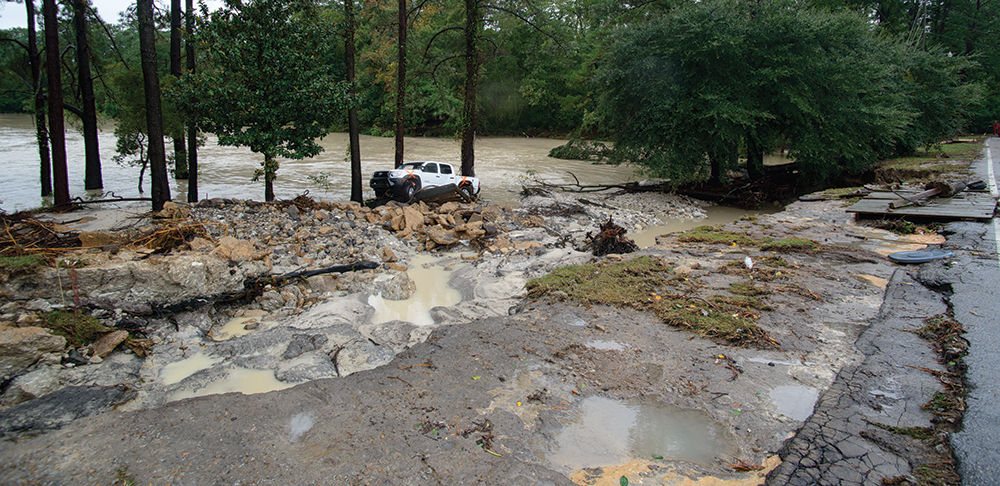
The new Clemson graduate program resulted from a dialogue among 30 faculty members across the campus from several colleges, including 18 who form the core of the group.
Co-principal investigators on the grant are all from Clemson and include: Jim Bottum, a research professor, the director of Clemson’s Center of Excellence for Next Generation Computing and Creativity and former chief information officer and vice provost for computing and information technology; Taufiquar Khan, a professor in the department of mathematical sciences; and Martin.
Students can expect a strong emphasis on collaborating across disciplines with students and faculty members.
“We were fortunate to have Dr. Russell Marion from the College of Education on our team,” Atamturktur said. “His expertise will enable us to not only train competent engineers and scientists but to immerse them in an enriching network of students. We will monitor how students network and how student interactions affect learning outcomes.
“It’s called social learning. Students will learn not only from advisers but also from interacting with other faculty and students. The student-faculty partnership will organically grow throughout their education.”
Tanju Karanfil, vice president for research, said Atamturktur and her team are creating a next-generation, engineering and science workforce that could save lives, especially in underserved parts of the world.
“Their innovative approach to graduate education is helping ensure that Clemson University, South Carolina and the nation stay on the cutting edge,” Karanfil said. “The research that students will do as part of the grant will help prepare them for careers in an area of national and global importance.”
Anand Gramopadhye, dean of the College of Engineering, Computing and Applied Sciences, said the new program represents a bold and potentially transformative approach to graduate education in science, technology, engineering and math.
“Dr. Atamturktur has developed a graduate program that is innovative, evidence-based and aligned with changing workforce and research needs,” Gramopadhye said. “The award is richly deserved.” ✲
SRIKANTH PILLA
Assistant Professor
Automotive Engineering
AMOD OGALE
Director of the Center for Advance Engineering Fibers and Films and Dow Chemical Professor
Chemical Engineering
By Paul Alongi
Two Clemson University faculty members are responding to a boom in South Carolina’s composite materials industry by diving into cutting-edge research that could have a direct impact on how cars and airplanes are made.
Srikanth Pilla is working to create an automobile door that is 42.5 percent lighter than a conventional one but still meets or exceeds the fit, finish and functional requirements. Amod Ogale is part of a nationwide team working to make composite materials less expensive so that they can be used more widely.
A composite material is made of two or more materials and is created because it has qualities superior to conventional materials. Composite materials are important to the making of cars, planes and other vehicles because they can be fashioned into parts that are stronger yet lighter than steel.
Manufacturers are ramping up composite materials production across South Carolina as the area’s automotive and aerospace industries continue to grow.
Companies in the composites and advanced materials sector announced $1.5 billion in capital investment in South Carolina from 2006-13, creating more than 2,700 jobs, according to the state Department of Commerce.
Ground was broken last year on one of those projects, a $1.4 billion Toray plant in Spartanburg County that is expected to create 500 jobs. Also last year, Teijen announced plans to build a state-of-the-art manufacturing facility in Greenwood County, creating 220 jobs.
Pilla, an assistant professor in the Department of Automotive Engineering, said the biggest driving factor behind the switch from metal to composite materials is that they are stronger and lighter, but they can also improve product design, assembly and quality.
For example, a standard hatchback or sedan will employ about 300 parts for assembly, but BMW reduced the number to 110 in its i3 model by using composites.
“It’s a big advantage,” Pilla said. “No. 1, the assembly time will be much less. You’re also reducing the number of interfaces, which increases the likelihood of success.”
The carbon fibers in Ogale’s lab are strands that look as unremarkable as string when wrapped on a spool. But when they are glued together with special polymers, they form super-strong composite materials.
The objective of his latest research is to help make a low-cost feedstock — which is the raw material that goes into composite materials — and a manufacturing process. The material would be called TuFF, which stands for tailorable universal feedstock for forming, said Ogale who is the director of the Center for Advanced Engineering Fibers and Films and Dow Chemical Professor of Chemical Engineering.
He has received $2 million for his team’s part of the $14.9-million research project, which is based out of the Center for Composite Materials at the University of Delaware. The research is funded by the Defense Advanced Research Project Agency.
“Carbon fibers are used commercially in high-performance aircraft applications, including some in the Boeing 787 Dreamliner,” Ogale said. “However, such fibers are also very expensive, so there is significant interest in reducing their cost.”
South Carolina had a head start in producing carbon fibers. The state was at the center of the textile-manufacturing universe through much of the 20th century. Then other countries that could offer cheaper materials and labor entered the picture.
When textile jobs started heading overseas, some companies began to pivot to composite materials. Clemson has followed suit by reshaping some of its academic and research programs to reflect industry needs.
Pilla is doing his research at the Clemson University International Center for Automotive Research (CU-ICAR) in Greenville. He said he is pioneering “a new cross-functional focus area” in composites that he terms “intelligent revitalization of composites design and manufacturing.” His door project, funded through a $5.81-million grant from the Department of Energy, is a prime example.
Under his leadership, a nationwide team of researchers is using carbon fiber reinforced thermoplastic composites to fabricate a driver’s-side front-door assembly for a large original equipment manufacturer.
The technology could also be used to create other vehicle parts and hit the market by 2022.
Pilla said he hopes the research will help shatter the common misconception that metals are stronger than composite materials. He wants to prove that they can work, maybe even to build almost an entire car.
“The door project is not about just planning it out on paper,” he said. “It’s manufacturing the door and then testing it out on a vehicle and proving that it has the same functionality as a metallic door. Once we prove that successfully, it’s a big win-win for the students who worked on it, the faculty who advised them, the suppliers that supported the work, the OEM that guided the team, and above all the Department of Energy who entrusted the team.” ✲
THOMAS HASH
Class of 1969 – Mechanical Engineering
By Heidi Williams
Clemson donor Thomas Hash could simply have chosen to retire to a better way of life.
Instead he decided to inspire a higher quality of life — by creating a $2 million endowment to Clemson University. His donation, which funds the Thomas F. Hash ’69 Endowed Chair in Sustainable Development, is an integral part of the South Carolina SmartState Program’s Center for Sustainable Development, which now has more than $8 million in funding. Researchers with the sustainable development center are developing new sensors and other technology that collect massive amounts of data that can be deployed to measure everything from water quality in rivers to traffic flow on highways. They hope the data will give policymakers the critical information they need to manage development sustainably as a growing population, depletion of resources and climate change make the task more difficult.
Hash, a 1969 graduate of Clemson University’s mechanical engineering program, spent the better part of his career serving as a senior executive with one of the world’s largest engineering and construction firms, Bechtel Corp., until he retired in 2008. During his tenure, sustainability became a key focus of the organization’s core values.
He retired right about the time he became a grandparent, and then a financial adviser asked him about plans for philanthropic giving.
“It was a trifecta of events,” Hash recalled recently from his home near Charleston. “I had done this thing with Bechtel where I became familiar with the principles of sustainability and why they were important. I was doing some estate planning, and then my first granddaughter was born. You put all that together, and I said, ‘I ought to do something that would help my grandkids and help the future of the world.’”
Hash and his wife, Caroline, split their time between the South Carolina coast, Annapolis, Maryland, and the Upstate. Likewise, they divide their energies between equal parts travel, service and family: They generously support a children’s home in Honduras (The Lamb Institute) through gifts and hands-on volunteering and, over the years, Hash has served in various advisery and service roles at the University, including on the Athletic Cabinet for the Board of Trustees and the Clemson University Foundation board.
Today, Hash — who at one time was a competitive clay shooter — volunteers as an instructor with the Clemson Shotgun Team and helps teach some University leisure skills classes for beginner and advanced shotgun classes.
But his contribution to the sustainable development program is perhaps the most direct link to his business and engineering background: In 2002, as a board member at Bechtel, he participated in a 10-year reassessment of the company’s “vision and values” statement.
“After six months of reading and study and interviewing customers, we added sustainability to that statement,” Hash explained. “We rewrote procedures about acquiring new businesses to include looking at the sustainability of a project.”
That ethic then became a key element of hiring and retaining the nation’s best engineering graduates for the company.
“Companies are first and foremost responsible to their shareholders: If it makes good business sense, you do it, and sustainability makes good sense,” Hash said. “One of the reasons companies are beginning to be concerned about it has a lot to do with recruiting young engineers. They want to know about it, and if you have nothing to say about sustainability, attaining new talent is more difficult.”
Clemson, by virtue of the Hash endowment, was able in 2015 to recruit Amy Landis, a professor in the Glenn Department of Civil Engineering and the Thomas F. Hash ’69 SmartState Endowed Chair in Sustainable Development. She is charged with coordinating the SmartState Center of Economic Excellence in Sustainable Development. As part of the program, the General Assembly provides a dollar-for-dollar state funding match through the South Carolina Education Lottery.
Hash receives a report from Landis annually, per his request, where he is able to see the accomplishments of the prior year and review the goals for the coming year.
The endowment has proven rewarding for Hash personally and philanthropically.
“The University has bent over backward to satisfy my thirst for information,” he said. “You get out of this what you want; if the donor sets the stage for his or her expectations, the University is very responsive and accommodating.” ✲

Meet Amy Landis, the nationally respected researcher whose research is made possible by the generosity of Thomas Hash.
Landis is a faculty member in the Glenn Department of Civil Engineering and the Thomas F. Hash ’69 SmartState Endowed Chair in Sustainable Development. In her role, she coordinates the SmartState Center of Economic Excellence in Sustainable Development.
Landis was the principal investigator on a $1.3 million grant from the U.S. Department of Energy to establish the Clemson University Industrial Assessment Center. The center provides free energy, productivity and waste assessments to small- and medium-sized industrial facilities.
Clemson was among 28 higher education institutions across the country that collectively received $35 million as part of the Industrial Assessment Center program.
“Clemson is on the cusp of a new vision and really exciting change,” Landis said. “I’m thrilled to be part of sustainability at Clemson and am honored to work with such talented students, faculty and alumni.”
BRIAN DEAN
Associate Professor – School of Computing
By Paul Alongi
One of Clemson University’s most highly regarded teachers is Brian Dean, an associate professor in the School of Computing.
His approach has been described as both innovative and challenging, a combination reflected in his reviews on ratemyprofessors.com. Students not only leave glowing comments, they have also given him a quality rating of 4.6 out of 5 and a difficulty score of 4.4 out of 5.
Dean won this year’s Philip Prince Award for Innovation in Teaching. The University award recognizes outstanding faculty members who demonstrate creative and novel teaching methods and is named for former Clemson President Philip Prince.
Aside from the courses he teaches at Clemson, Dean volunteers a tremendous amount of time doing educational outreach. Most notably, he directs the USA Computing Olympiad (usaco.org), which provides online educational materials and programming competitions that thousands of high-school students worldwide have used to improve their computational problem-solving skills.
Dean recently took some time to answer a few questions about what drives, excites and challenges him.
Why do you teach?
Working with bright energetic students helps me maintain enthusiasm for my field of study. It’s also a surprisingly good way to learn, and I feel like it therefore makes me a better scholar.
What accomplishment are you most proud of?
I received a letter from a parent of one of our Olympiad students once that started with “thank you for changing my son’s life,” describing how the student returned home from our program inspired to pursue advanced computing and is now having amazing success in these studies at one of the top universities in the country. I’m happiest when I hear reports like this about former students’ success.
What’s the most challenging part about teaching?
Articulating advanced concepts clearly can certainly be a challenge. However, telling the students how to answer questions isn’t the real hard part. At the end of the day, learning requires hard work and commitment of substantial time on the part of the student. There aren’t any shortcuts. The challenge is to inspire students to want to make this investment.
What can students expect from your class?
They can expect to work hard and challenge themselves to become better problem solvers, but to do so in a fun, supportive environment.
Do you think you’re a tough grader?
Absolutely. I’ve rarely given a test with an average above 50 percent, and no student has ever earned a perfect score on any test I’ve given in the 10-plus years I’ve been at Clemson.
Why do you think students respond so well to you?
I love what I teach, and I hope this enthusiasm and passion connects with the students. I also try to make sure students feel I am easily approachable and that I am on their side; even though I’m a tough grader, I want to make sure students feel their grades are reasonable and fair.
Could you please tell us about some of the innovative aspects of your teaching, including whiteboard lectures, animated videos, “making mathematical reasoning fun,” and the “recommendation system” for restaurants?
Animated whiteboard lectures: Many concepts in my field, computer science, are hard to explain using just text or a static picture. To remedy this, I use videos a lot in my teaching. For example, every programming assignment solution I post online is actually a video showing the process of me writing the code and explaining my thought process along the way. I’ve also written two generations of a program called LectureScribe, now used by many other educators, for creating online “pencast” videos that record writing on a tablet/whiteboard along with audio. I’m planning to incorporate several hundred videos of this style in a mixed-media textbook I’m currently writing. It explains concepts at a high level in text, while proofs and more complicated concepts are articulated using pencast videos accessible by hyperlinks or QR codes.
Making mathematical reasoning fun: It’s already fun! Of course, the challenge is helping students realize this. It can help if assignments have a playful side. For example, for a recent assignment I gave students programs I wrote and asked them to play the role of “evil supervillain” to look for inputs that would make my programs run badly.
Recommendation systems: I think it’s fun to start class with an enticing question that will be answered by whatever concept is the topic of discussion for the day. For example, “Where should I eat lunch today?” Well, let’s write code that shows how to build a recommendation system that aggregates the dining suggestions of the students in class to issue suggestions. A few weeks ago, we started class with the question “What is the 17th largest state in the U.S. by area?” and wrote a program that systematically traversed a picture of a U.S. map to count up the areas of the different states to get the answer. This week, we used dynamic programming algorithms to compose music. Keeping some level of suspense until the answer is revealed at the end of class helps keep students engaged.
What’s the latest on the Computing Olympiad? Do students still train in Clemson? What do you have planned for the Olympiad this summer?
We continue to hold a training camp at Clemson every summer for the top two dozen high-school computing students in the U.S. — a very talented group. This coming summer the International Olympiad in Informatics will be held in Tehran, Iran, one of its more exotic destinations in recent history. Barring visa or other diplomatic issues, we will be bringing a team of our top four students to compete. It should be an awesome experience! ✲
Shaping Our Future ♦ IDEAS Spring 2017
STUDENT SPOTLIGHT
By Hannah Davis
At Clemson University, students engage in groundbreaking research, design innovative solutions and build novel devices. And they use a wide range of learning experiences for more than just advancing their career ambitions.
From creating a new source of energy for a devastated Belizean village to developing an inexpensive glucometer for low-income diabetics, three highly accomplished students in our college discuss contributing to resources that support the well-being of others at home and abroad.
MYRTEDE ALFRED
Graduate Research Assistant
Industrial Engineering
SHAKIRA HOBBS
Graduate Research Assistant
Civil Engineering
Shakira Hobbs and Myrtede Alfred were expecting a warm welcome when they arrived in Belize, not a hurricane. When the two Clemson University Ph.D. candidates first arrived in the Sittee River Village for their two week trip, they encountered both.
Hobbs said she learned of the impending storm as she and Alfred walked through the airport in Belize.
“Everyone was on edge and asking us what we were going to do to prepare, and we didn’t have a clue of what they were talking about,” Hobbs said. “When we arrived at the Sittee River Village, stores were closing, people were boarding their houses, and some were even evacuating. It was alarming, but we knew we had work to do. We ended up staying through the storm, and it ended up passing through overnight while we were asleep.”
Community engagement was an important aspect of their trip. The bad weather created opportunities to form relationships with the village members. The hurricane delayed their schedule to start surveying the community, so instead they had the chance to engage in activities with locals.
Throughout their stay, they played basketball against the young boys in the village, led different activities with children at a summer program, and participated in a charity walk to benefit the children of a nurse who had died from cancer earlier that year. They also canoed through flooded river and streets with some locals for food and supplies.
“Shakira asked me if I wanted to kayak to the local store and I figured she wanted to buy supplies to help with some of the storm reconstruction,” Alfred said. “Instead, she was willing to kayak at night through crocodile infested water to get food for a barbecue.”
“I laughed at first at the offer, then next thing I knew four of us were canoeing and kayaking on top of flooded streets. Small things we did like this helped us to bond with, understand and learn about those in the village. That in turn benefited the work we were trying to do.”
Once Hurricane Earl passed, Alfred and Hobbs were able to begin their work. A survey conducted earlier by Hobbs showed that those living in the village thought there were better ways of managing their waste rather than burning, burying, or throwing it in the river.
The goal of the project was to determine how much food waste was produced in the village and resorts nearby, and how much of that waste could be converted into methane, creating a new source of energy for the village.
Throughout the week, they had to conduct their own census and collected waste from several households and resorts in the village. Now that they are back in Clemson, they are working on how they can implement their ideas to change for the village.
“If we did not have the support of the village our efforts would be meaningless,” Hobbs said. “The council within the village was made up of community leaders and we wanted their approval before we started. Throughout our time there we were able to form valuable relationships with the locals that have changed my life. I learned that they do not necessarily need our help and we are not their saviors. They are kind enough to let us implement our ideas and trust us throughout the process.”
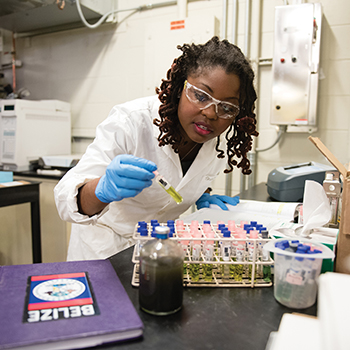
Shakira Hobbs in the lab
Alfred and Hobbs do not intend to lose their ties to the Sittee River Village throughout the next couple of years. Although their next trip is not set, they are currently working on two journal articles on their findings in Belize. They intend for their next trip to Sittee River to focus on sustainability and to incorporate recycling. They are also hoping to build a prototype of an anaerobic digester so the community can see how the technology works.
In the future, Hobbs wants to use her knowledge to teach and encourage students to be agents of change through active and service learning trips.
“Above all, education is key,” she said. “The pursuit of happiness is key. Education is important but it shouldn’t be the only thing. Our above all question is whether or not our work will make people happy. That is what’s most important.” ✲
Joey Wilson
Class of 2017
Bioengineering
Schwarzman Scholar
By Hannah Davis
Before his freshman year even began, Joey Wilson was on campus conducting bioengineering research alongside a distinguished faculty mentor. The list of accomplishments he has accumulated since then is nothing short of impressive — Schwarzman Scholar, undergraduate student body president, winner of the Astronaut Foundation Scholarship. And it goes on.
He arrived at Clemson as a graduate of South Carolina’s Governor’s School for Science and Math, on academic scholarship and as part of the Calhoun Honors College. The opportunity to earn college credit and gain valuable experience on an accelerated schedule through EUREKA!, the Honors College summer research program, is what drew the Duncan, S.C., native to Clemson in the first place.
Wilson has built lifelong connections with faculty mentors who would become some of his greatest supporters.
Since that foundational five-week period, he has continued developing innovative concepts, such as an inexpensive, easy-to-use glucometer for use in countries where local populations don’t have the resources to diagnose and treat diabetes before the disease turns deadly.
Through collaboration with Associate Professor Delphine Dean, Wilson is also researching ways to safely and effectively treat cancer using a specialized Electron Beam Ion Trap. This machine allows him to study the beneficial effects of low-dose radiation on healthy tissues, a phenomenon called hormesis.
“Research is about striving to leave a legacy of positive change, even if it’s just in one person’s life,” said Wilson. “I’m confident the work I’m doing as an undergraduate is preparing me for success in graduate school and life beyond, but I’m also passionate about using what I’ve learned to make a difference. And that’s what the Clemson experience is all about.”
Because of his work in the lab, Wilson has already published a paper and presented at three national Biomedical Engineering Society conferences. Clemson awarded him an education enrichment travel grant, which allowed him to make further progress in research at the Nanyang Technological University in Singapore, China, and visit many other countries across the globe.
Wilson taught English in Beijing, China, then traveled through Europe to the Balkans to learn about global politics and public policy as part of the Dixon Global Policy Scholars Program. He then conducted bioengineering research in Singapore and visited Indonesia, Thailand and Malaysia. Clemson also funded Wilson’s travels to London, Prague and Budapest for Model UN conferences.
“After talking with people of many different nationalities and hearing their perspectives, I came home inspired to support my own Clemson Family,” said Wilson.
He’s on the national student advisory board for the “It’s On Us” campaign, started by the White House to end sexual assault on college campuses, and considers his work with the movement to be one of his greatest achievements. Wilson even had the opportunity to share his ideas with former Vice President Joe Biden when he visited Clemson in 2016.
Currently serving as the undergraduate student body president, Wilson is actively involved on campus and has a strong vision for Clemson: inclusivity, transparency and student body support. That’s why he holds weekly office hours to hear questions, ideas and concerns from his peers.
In 2016 Wilson was the recipient of the Astronaut Foundation Scholarship, which provides a stipend of up to $10,000 and is awarded to students who demonstrate high academic merit in the STEM fields.
Most recently he was named a Schwarzman Scholar, a prestigious scholarship that will send him to study for one year at the Tsinghua University in Beijing. He will enroll in August 2017 to complete a master’s program in public policy.
“I wouldn’t be who I am today without the experience I’ve had at Clemson,” said Wilson. “I truly hope I can take what I’ve learned and continue to make the world a better place.” ✲

Left to right: Wilson started working with Dean before his freshman year through the EUREKA! program; his work with “It’s On Us” brought former Vice President Joe Biden to Clemson; enjoying Southeast Asia while teaching English; an active participant in campus life.
Alumni Spotlight
HOW CLEMSON’S CORE VALUES LED THE STANZIONE BROTHERS TO THE HEIGHTS OF INDUSTRY
It’s not every day that a single family produces a pair of brothers as successful as Bob and Dan Stanzione, both Clemson University engineering graduates who have reached the highest ranks of industry.
By Paul Alongi
Dan is president emeritus of Bell Laboratories and chairman of the boards at Quest Diagnostics and Internap. Bob is executive chairman of ARRIS International, a world market leader in cable telephony, high-speed data and video delivery products.
They are the only set of brothers to be inducted into the Thomas Green Clemson Academy of Engineers and Scientists, the highest honor bestowed by Clemson University’s College of Engineering, Computing and Applied Sciences.
What has kept them in touch with their alma mater goes beyond advanced calculus, fluid dynamics and other standard book lessons.
“For me, the values at Clemson then and now very much matched the values that our family had,” Dan said. “Hard work, integrity, the value of personal relationships, the value in other people regardless of their background — all those values were there when I was a student, and I think that they are still there.”
Those values are enshrined in the University’s curriculum, extracurricular programs and even in its buildings.
For example, the Stanziones said they were impressed with the Watt Family Innovation Center, a state-of-the-art building with classrooms and meeting space that opened a year ago.
Barbara Speziale, the associate director of the center, said everything from the round tables to the technology is designed to encourage collaboration. The center partners with Creative Inquiry, a program that brings together undergraduates from various majors to do research aimed at solving real-world problems.
“When students go off into the workforce and community, they need to have skills that are not just book knowledge,” said Speziale, who is also the Creative Inquiry director. “They need to work in teams. In Creative Inquiry, students learn to work with people who are not like them.”
Hard work, integrity, the value of personal relationships, the value in other people regardless of their background — all those values were there when I was a student at Clemson.
– Dan Stanzione
Dan received a bachelor’s degree in electrical engineering in 1967, a master’s degree in environmental systems engineering in 1968 and a Ph.D. in electrical engineering and computer science in 1972, all from Clemson.
Bob received a bachelor’s degree from Clemson in mechanical engineering in 1969 and a master’s degree in industrial engineering in 1971 from North Carolina State University.
Bob said that the same traits he seeks in new employees are the ones that will help the college achieve its goal of becoming a premier research college. They include persistence, determination, a willingness to invest and the right attitude on the teaching staff.
“The teaching staff is just critical,” he said. “The values and learnings that are presented in the classroom make all the difference in the world. I believe Clemson is on a path to continue to enhance its reputation as a leading engineering institution, and the quality of the graduates that it is producing will help elevate that reputation to higher and higher levels.”
Anand Gramopadhye, the college’s dean, said the values that the Stanziones and Clemson share serve as crucial guideposts.
“Bob and Dan Stanzione have made selfless service a cornerstone of their success,” Gramopadhye said. “Their business acumen and technological advancements are matched only by the social good they do without seeking recognition. Their support and service to Clemson are greatly appreciated.” ✲
News from Around the College

Clemson Ranks in Top 20 in Graduating African-American Engineering
Clemson University recently celebrated its ranking as the nation’s 20th highest producer of African-American undergraduates receiving baccalaureate degrees, as reported in the magazine Diverse Issues in Higher Education.…

Clemson’s Zucker Center Marks New Era of Engineering in Charleston
Clemson University recently opened its new $21.5 million Zucker Family Graduate Education Center, a 70,000-square-foot, state-of-the-art facility that will help shape the future of the state’s engineering landscape for generations to come.…

Siemens Bestows Largest In-Kind Technology Grant in University History
Clemson University has received the largest grant-in-kind in its history from Siemens, a global technology company, with software representing a commercial value of $357,224,294.…

April Gillens Makes African-American History at Clemson
April Gillens’ dream started in a rural South Carolina town, but it’s taken her to some of the nation’s most prestigious research institutions, including Los Alamos National Laboratory and the Massachusetts Institute of Technology.…

Johan Enslin to Lead Power and Energy Programs in Lowcountry
Johan Enslin is Clemson University’s new Duke Energy Endowed Chair in Smart Grid Technology and executive director of the energy systems program at the Clemson University Restoration Institute.…

Hai Yao Appointed to Ernest R. Norville Endowed Chair in Biomedical Engineering
A Clemson University professor who plays a key role in bringing together some of South Carolina’s leading minds for bioengineering research is the new Ernest R. Norville Endowed Chair in Biomedical Engineering.…

New Lab Equipment Heats up Clean-Energy Research at Clemson
Clemson’s new high-temperature melt solution calorimeter is helping South Carolina play a leading role in research that ensures nuclear waste is stored safely for generations to come. It’s the only calorimeter on the East Coast and one of five in the country.…

Venkat Krovi Positions South Carolina to Lead on Autonomous Vehicles
Venkat Krovi, the recently named Michelin Endowed Chair in Vehicle Automation at Clemson University, is starting an education and research program that could help South Carolina play a leading role in developing driverless automobiles.…

South Carolina Strengthens Position as Advanced Manufacturing Hub With BMW Endowed Chair
A Clemson University researcher creating the technology and educational programs that could give the U.S. an edge in the competitive world of advanced manufacturing is the new holder of an esteemed faculty position endowed by BMW…

Clemson’s Creative Inquiry Program Earns National Honor
The national Council on Undergraduate Research (CUR) recognizes campuses demonstrating characteristics of excellence in undergraduate research. CUR has selected Clemson University and its Creative Inquiry program for a 2016 campus-wide Award for Undergraduate Research Accomplishment (AURA).…
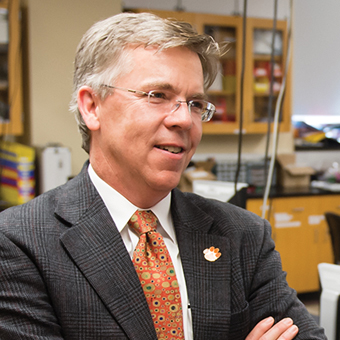
Jeremy Gilbert Named Hansjörg Wyss Endowed Chair for Regenerative Medicine
One of the Charleston area’s newest engineers is an internationally renowned researcher who takes an unconventional approach to studying how metal interacts with the body, a field that affects millions of implant patients each year.…
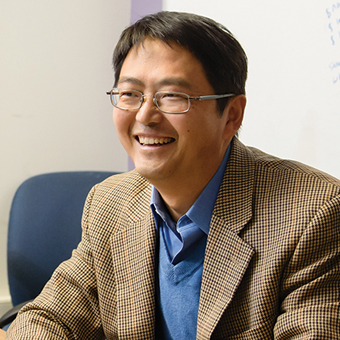
Research Takes Aim at Devastating Citrus Disease
South Carolina is known more for peaches than oranges when it comes to fruit, but researchers in the state could play a key role in saving the nation’s citrus industry from an insect-borne disease that has devastated crops in Florida and threatens other states from California to Texas.…
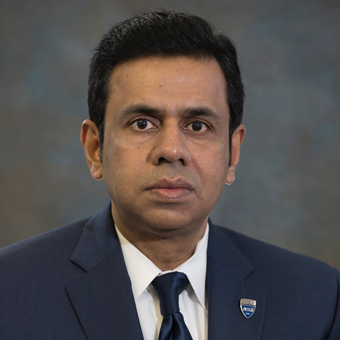
Research Led by Clemson Could Help Revolutionize Transportation
Mashrur “Ronnie” Chowdhury envisions a future in which car accidents will be reduced to virtually zero and drivers will travel down some of the state’s busiest roads without stopping for a single traffic light.…
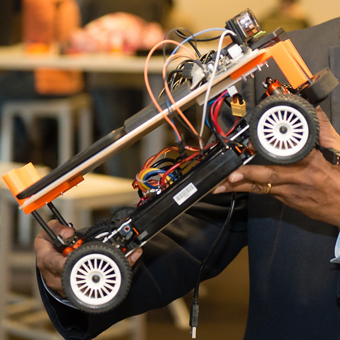
Clemson to Play Leading Role in $253 Million Plan to Use More Robots in Advanced Manufacturing
Clemson University experts will help develop next-generation robots and play a leading role in training the workers who operate them as part of a $253 million plan that aims to fill 510,000 potential new manufacturing jobs across the country by 2025.…

David Freedman and His Team Dig Deep to Answer Questions about Water Safety
David Freedman, the chair of the environmental engineering and earth sciences department at Clemson, is serving as the principal investigator on a study examining whether natural processes are breaking down solvents that were released into the environment before their health hazards were fully understood.…
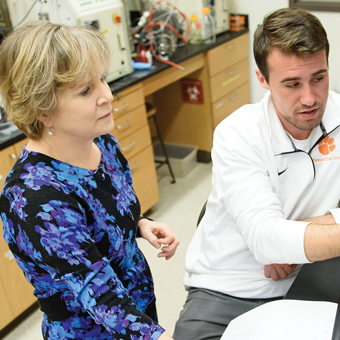
Clemson Team is Part of a New Institute Advancing the Nation’s Leadership in the Biopharmaceutical Industry.
The National Institute for Innovation in Manufacturing Biopharmaceuticals (NIIMBL), joins 11 other institutes in the Manufacturing USA network and is the first institute with a focus area proposed by industry and funded by the U.S. Department of Commerce.…

Ballato Named Fellow of Top Engineering Organization
A Clemson professor who is credited with pioneering innovations in the optical fibers that are critical to lasers and long-distance communication was elevated to Fellow of the professional organization IEEE.…
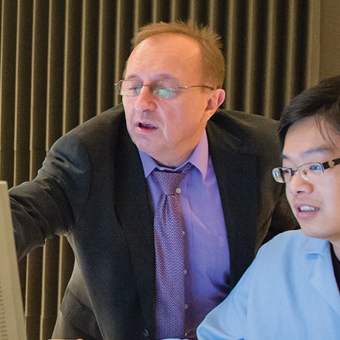
Urban Named ACS Fellow
Marek Urban of Clemson was selected as a Fellow in the American Chemical Society’s Division of Polymeric Materials: Science and Engineering.…
Facility Spotlight
The Fluor Engineering and Science Study Hall has been one of the most valuable, free tutoring programs available to students in the College of Engineering, Computing and Applied Sciences since it opened its doors five years ago. That popularity has drawn continued investment from the University and generous donors, including Fluor.
The study hall got a brand-new space in Freeman Hall heading into the 2016-17 academic year, creating an even more open and inviting environment for learning that is fully integrated with technology. Through the generosity of Fluor, paid tutors are able to staff the center and assist with most of the undergraduate coursework in engineering and science.
Many students discover Fluor Study Hall as freshmen through PEER and WISE mentoring programs for under-represented students in CECAS. However, as the facility has been upgraded and improved, so has awareness of its offerings.
“Outreach and support are key parts of the engineering and science programs offered at Clemson,” said Serita Acker, director of PEER/WISE at Clemson. “We are here to help students find success as they pursue their degrees and prepare for careers in science and engineering.”
Fluor Study Hall is is open five nights a week, Sunday through Thursday, to all Clemson math and science students. On any given night upwards of two dozen or more students can be found working with tutors, either by appointment or as drop-ins. Tutors are juniors, seniors and graduate students in the College of Engineering, Computing and Applied Sciences.
For more information about the Study Hall, contact PEER coordinator Lisa Jackson at ljacks6@clemson.edu or 864-656-6109.
Alex Bina (left), Gregory Batt (center) and John DesJardins (right) are working with Jay Elmore, owner of Green Gridiron, to create facemask designs that will improve the overall safety of football helmets. Here they place a helmet on an anthropomorphic head model and use a linear drop tower to generate a simulated football head impact. Batt is an assistant professor in the Clemson food, nutrition and packaging sciences department; John DesJardins is an associate professor of bioengineering and director of the Laboratory of Orthopaedic Design and Engineering; and Alex Bina is a doctoral student in bioengineering and a graduate research assistant in food, nutrition and packaging sciences. The team has received a nearly $50,000 grant from the Robert H. Brooks Sports Science Institute to conduct their study.



